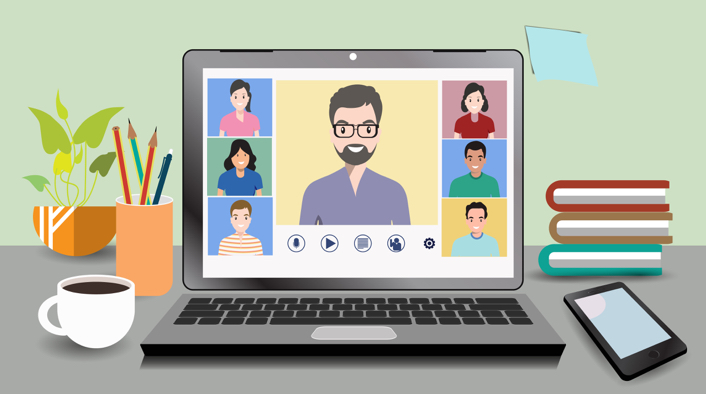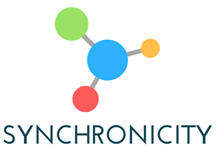A faculty-led initiative at Indiana Wesleyan University/National & Global Campus focused on creating real-time engagements with students in asynchronous online courses.


Over the past year, a collaborative team of administrators and faculty from Indiana Wesleyan University's adult education programs, National & Global (IWU/N&G), developed and deployed an approach to teaching and learning for students of asynchronous online programs. Although this initiative—dubbed Synchronicity—is not revolutionary in the scheme of online teaching, it demonstrates the power of engaging faculty in the process of systemic change. The team's belief in the benefits of blended online learning—that is, the thoughtful integration of synchronous and asynchronous online modalities—was inspired by the professional literature,1 as well as student data from a pilot study at IWU/N&G.
The Pilot Study: January to June 2020
In January 2020, sixteen IWU/N&G faculty began an interdisciplinary research effort to compare student outcomes between fully asynchronous versions of online courses and other versions that blend asynchronous and synchronous elements. Faculty participating in the pilot study implemented at least one synchronous learning activity in their online courses and made the activities optional for students. Examples of synchronous learning activities included welcome sessions, discussions, and virtual office hours.
Faculty participating in the pilot study recruited colleagues who taught the same or similar online courses without synchronous components. A short survey for students examined overall course effectiveness for both groups (online courses taught with and without synchronous components). The survey consisted of five questions but did not explicitly mention the synchronous approach. Of interest, students rated "I connected with my professor as the course went along" as statistically significantly higher in the course with the synchronous component (p < .05).
In cases where Synchronicity faculty could not compare their online course to the same or a similar course taught without synchronous components, a longer survey with open-ended questions was administered. Student participants overwhelmingly indicated an appreciation for faculty who provided synchronous components. The following are sample comments taken from the qualitative student survey:
- "Having a real-time meeting with the class gave me a chance to speak to classmates that I have been learning with for over a year."
- "The most important part of the learning experience is the archive ability of the videos. Going back and being able to re-watch a lecture is invaluable."
- "I loved this experience. It was like being in the classroom, and I was able to ask questions and get to know classmates. Real-time feedback was essential to my learning."
- "Since I am learning online, the live, synchronous time gave me a learning opportunity a bit closer to the traditional classroom experience."
- "I thought it was a great aid for clarifying the content and bouncing ideas off the instructor. She was able to show us screenshots of tables to make the assignment easier."
Faculty participating in the pilot study identified specific instances in which synchronous online learning seemed to most benefit students. From these instances, five themes emerged: course welcome, office hours, mini-lectures/subject-matter experts, complex subjects, and collaborative assignments (see table 1).
Table 1. Benefits of synchronous activities for online learners
| Theme | Purpose | Description |
|---|---|---|
|
Course Welcome |
Establish Trust/Enthusiasm for the Learning Ahead |
|
|
Office Hours |
Ongoing As-Needed Support and Assistance |
|
|
Mini-Lectures/Subject-Matter Experts |
Amplifying Course Content |
|
Complex Support |
Content Mastery |
|
|
Collaborative Assignments |
Peer Review |
|
In each instance, faculty participants advertised the synchronous activities to their students with posts in the learning management system and emails to encourage attendance. In most cases, faculty participants recorded welcome sessions, mini-lectures, and complex support for students who could not attend the live session. Although different synchronous activities aligned better with different learning outcomes and course subjects, faculty of the pilot study concluded that all online courses could benefit from the thoughtful integration of synchronous and asynchronous online learning activities.
The Training Season: September to December 2020
The overwhelming buy-in from faculty in the pilot study led to cabinet-level approval of Synchronicity as a viable approach for all online programs of IWU/N&G. Training was created and launched to ensure that all IWU/N&G faculty were introduced to this approach and equipped to facilitate synchronous activities of their choice. Faculty could complete the Synchronicity training in one of three ways:
- Online by completing a training course on the learning management system
- Online by participating in a Synchronicity webinar
- Onsite at IWU Regional Education Centers
To date, more than 300 faculty have completed Synchronicity training. The response from participants has been overwhelmingly positive, as illustrated in the following feedback from the training survey:
- "I appreciate that Synchronicity was presented as highly valuable but also optional for students."
- "This was helpful to me as I try to learn how to be an online instructor after 15 years of teaching onsite only at IWU."
- "This affirmed the pre-course Zoom meetings I have been doing and offered some ideas for other possibilities."
- "Thank you for offering a variety of platforms for this training!"
The Next Phase: January to June 2021
The Center for Learning and Innovation (CLI) at IWU/N&G has made a commitment to provide ongoing training and support for the Synchronicity initiative. This spring, CLI will offer weekly webinars to allow faculty to discuss challenges and opportunities based on their experiences with synchronous online learning activities. In addition to the discussion-based webinars, topic-centric webinar offerings will be available to demonstrate specific Zoom and facilitation practices (e.g., breakout rooms, polling, whiteboards, Kahoot, Padlet, Wheel of Names). CLI also plans to conduct a thematic analysis of end-of-course survey data to explore student reactions to optional synchronous online learning activities.
The Final Word
As is the case with any instructional strategy, when faculty are presented with information about synchronous online sessions, some are die-hard proponents, others are fence-straddlers, and a few admit reluctance. Typically, those who are reluctant either have tried synchronous sessions and experienced disappointment in student attendance and engagement or have not tried synchronous sessions and do not feel equipped to facilitate learning in a live virtual format. The process of integrating synchronous activities in asynchronous classes may feel daunting, unfamiliar, and frustrating at times. Faculty have been encouraged to start slowly by focusing on a single class and one or two technologies. Furthermore, faculty are encouraged to heavily advertise the sessions to students and explicitly share the intended outcomes. Whenever faculty experiment with new technologies, they will experience hiccups, but perseverance is worthwhile.
If you are considering experimenting with optional online synchronous activities in the days and months ahead, consider this advice:
- Schedule a Zoom meeting with your colleagues to experiment with synchronous online technologies (e.g., Zoom), share your experiences, and demonstrate facilitation skills.
- Administer a brief survey in your course to allow students to give feedback on the optional online synchronous activities.
- Reach out to your institution's instructional design team to collaborate on where to add an optional synchronous online learning experience based on the course and student learning outcomes. Consider what student outcomes are best achieved through face-to-face or real-time online interactions, and what student outcomes are best achieved through preloaded online course content and design.
The physical separation of instructors and students in asynchronous online education poses challenges for fundamental activities of learning, including building relationships, establishing trust, and communicating warmth.2 Synchronous activities allow faculty to lessen the perceived physical and psychological distance between them and their students. As with a traditional, face-to-face classroom setting, students in synchronous online sessions will hear vocal intonation, observe facial expressions, and even witness their instructor slip up on occasion (and that's okay!). It is in these interactions that students see authenticity and begin to experience the immediacy, or "closeness," that they want and need for optimal learning. The future of online teaching in higher education hinges on the adoption of blended online learning modalities driven by faculty involvement.
For more insights about advancing teaching and learning through IT innovation, please visit the EDUCAUSE Review Transforming Higher Ed blog as well as the EDUCAUSE Learning Initiative and Student Success web pages.
The Transforming Higher Ed blog editors welcome submissions. Please contact us at [email protected].
Notes
- Jennifer Kreie, Sandra Johnson, and Michelle Lebsock, "Course Design and Technology for Synchronous Interaction in an Online Course," Information Systems Education Journal 15, no. 5 (September 2017): 60–67; Florence Martin, Chuang Wang, and Ayesha Sadaf, "Facilitation Matters: Instructor Perception of Helpfulness of Facilitation Strategies in Online Courses," Online Learning 24, no. 1 (March 2020): 28–49. ↩
- Anna Espasa, Teresa Guasch, Rosa M. Mayordomo, Montserrat Martínez-Melo, and David Carless, "A Dialogic Feedback Index Measuring Key Aspects of Feedback Processes in Online Learning Environments," Higher Education Research & Development 37, no. 3 (January 2018): 499–513. ↩
Tiffany Snyder is Assistant Director of Faculty Enrichment at Indiana Wesleyan University.
Brad Garner is Director of Faculty Enrichment at Indiana Wesleyan University.
© 2020 Tiffany Snyder and Brad Garner. The text of this work is licensed under a Creative Commons BY-ND-ND 4.0 International License.
